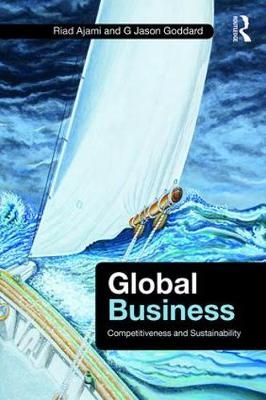
Global Business
Routledge (Verlag)
978-1-138-55179-4 (ISBN)
Globalization has been under extreme pressure in the wake of the financial crisis. Multinational firms are weighing the costs and benefits of international scale and scope, and are increasingly under pressure to hire local, to source local, and to pay taxes domestically. At the same time global competitive pressures have intensified.
This book reviews international business practices from the multinational firm perspective, and provides pathways forward concerning competitiveness and sustainability in global markets. What sets this book apart from others is that the benefits and pitfalls of globalization are addressed. Chapter coverage focuses on the functional areas of the business and how they are impacted by international expansion. Practical case studies supplement chapter coverage and highlight both positive and negative developments in the global business arena. Readers should expect to be challenged on what will be the limits of the multinational firm in the future, and how multinational firms can continue to prosper while at the same time adhere to sustainable business initiatives.
Equally useful to both undergraduate and graduate students of international business as well as professional development programs, Global Business: Competitiveness and Sustainability provides a necessary tonic for dealing with today’s troubled seas of globalization.
Riad A. Ajami is currently Professor of International Management and Global Strategy at the Raj Soin College of Business at Wright State University, USA. Professor Ajami is the Editor-in-Chief of the Journal of Asia-Pacific Business and Editor-in-Chief of the Haworth International Business Press Series in Asia-Pacific Business. He has appeared on national television and radio, including, among others, Nightline, the PBS News Hour, NBC News, CNN, National Public Radio and CBS Radio. G. Jason Goddard is Vice President at Wells Fargo Bank, where he has been a commercial lender for over 20 years. He obtained his MBA from the University of North Carolina at Greensboro, USA. Mr. Goddard is currently Adjunct Professor at Wake Forest University and UNC-Greensboro, and is the Associate Editor of the Journal of Asia-Pacific Business, where he has authored numerous articles. Mr. Goddard teaches the investment real estate course at Wake Forest University, USA, and has taught international business and international finance at UNCG and in Ludwigshafen Germany at the University of Applied Sciences.
Chapter One: Global Business: Competitiveness and Sustainability 1
Globalization: Detractors and Supporters 2
Global Business: The Balance of Competitiveness and Sustainability 4
Thematic Definition of the Field of International Business 10
Chapter Two: International Marketing 11
What Must Be Done: The International Marketer’s Dilemma 11
To Centralize or Decentralize: The First Key Decisions 12
Ethnocentric, Geocentric, & Polycentric Approaches 14
Product Decisions 14
Promotional Tools 16
Personal Selling 17
Sales Promotions 18
Publicity and Public Relations 18
Pricing Decisions 18
Pricing Methods 19
Placement Decisions: Distribution of Products 22
The Importance of Placement 22
Factors Involved in Distribution Decisions 23
Summary 26
Discussion Questions 27
Bibliography 28
Appendix: A Checklist for Export Marketing 30
Chapter Three: International Finance 33
Financing International Business 33
Working Capital Management 33
Intra-company Pooling 36
Hedging Against Inflation 37
Managing Blocked Funds 37
Transfer Pricing 39
Capital Budgeting and Financial Structure of an MNC 40
Exchange Control Restrictions on Remittances 40
Political Risks 40
Tax Considerations 40
Sources of Funds 41
Currency of Borrowing Investments 41
Different Inflation Rates 42
Letters of Credit in International Trade 43
International Capital Markets 43
The Emergence of International Capital Markets 44
National Financial Markets 45
The Euromarkets 46
International Equities Markets 49
Emerging Markets 51
Summary 52
Discussion Questions 53
Bibliography 54
Chapter Four: International Accounting 55
What is Accounting? 55
Differences in Accounting Practices Among Countries 56
Factors Affecting Accounting Systems 56
What Type of Differences Emerge? 57
Differences in Valuation 58
The Impact of Accounting Differences 58
Differences in Disclosure 59
Segmentation of Accounting 60
Social Reporting 62
Policy Formation and Harmonization 63
Determining Policy 63
Policymaking in the United States 63
Policymaking in other Countries 63
Harmonization 64
Regional Harmonization Efforts 65
Special Accounting Problems 66
Differences in Currency Exchange Rates 67
Consolidation Problems 70
Inflation 72
Transfer Pricing and Costing 73
Other International Accounting Issues 74
Accounting for Expropriation 74
Planning and Control 74
Auditing 75
Summary 75
Discussion Questions 75
Bibliography 77
Chapter Five: International Taxation 79
Why Taxes? 79
Types of Taxes 80
Income Taxes 80
Transaction Taxes 81
Value-Added Taxes 81
Excise Taxes 82
Extraction Taxes 82
Tariffs (Border Taxes) 82
Tax Compliance and Tax Enforcement 82
International Taxation 85
Taxes: MNC 85
Taxes: U.S. Controlled Foreign Corporations 85
Double Taxation 86
Tax Treaties 86
Foreign Tax Credits for U.S. Corporations 87
Special Issues and Problems in International Taxation 89
Tax Havens 89
Transfer Pricing 90
Unitary Taxes 90
Tax Incentives for International Business 91
Foreign Sales Corporations 91
Domestic International Sales Corporations 92
U.S. Possessions Corporations 92
Influence of U.S. Tax Law on Corporate Operations 93
Taxation of Individual Foreign Source Income 93
Expenses of U.S. Expatriates 94
Summary 94
Discussion Questions 95
Bibliography 96
Chapter Six: International Staffing and Labor Issues 97
Organizing a Multinational Corporation 97
Function Structure 98
Regional Structure 98
Product Structure 98
Matrix Structure 98
International Staffing 98
Recruitment 98
Selection 99
Training 100
Motivation 101
Managerial Staffing 101
Value to Firm 101
Branch Manager versus Home Office: Who Is In Charge? 102
Branch Managers: Who Should Firms Choose? 103
Choosing Branch Managers: Selection Criteria 104
Labor Pool 104
Corporate Policies 104
Desired Local Image 104
Local Employee Incentives 104
Existing Methods of Selection 105
Potential For Culture Shock 105
Training Branch Managers 105
Alternative Models 106
Compensating Branch Managers 107
Wages 107
Taxes 107
Repatriating Branch Managers 107
Reverse Culture Shock 107
Ethical Issues 108
Female Managers Overseas 108
Overseas Assignments as Dumping Grounds 109
International Labor Issues 109
Managing an International Work Force 109
Wages and Benefits 110
Job Security and Layoffs 111
Labor Productivity 112
Technology 112
Labor Unions 113
MNC Tactics 122
Counter-Tactics by Labor 123
International Unions 123
Codetermination 124
Summary 124
Discussion Questions 125
Bibliography 126
Chapter Seven: Managing Global Operations and Technology 127
Operations, Technology, and International Competition 127
International Production and Operations 128
Worldwide Standardization 128
Supply 128
Control 129
Controlling Strategically 129
Areas to Control 129
Designing the Local Operations System 132
Plant Location 133
Plant Layout 133
Materials Handling 133
Staffing 133
Production and Operations Management 133
Productive Activities 134
Supportive Activities 135
Just-In-Time System 136
International Technology 136
Diffusion of Technology 137
Technology Development 137
Technology Transfer 138
Choice of Production Technology 139
Pricing Technology Transfers 141
Protecting Technology 142
Management Information Systems 142
MIS in an MNC 142
Corporate Reports 143
International Data Processing: Integration Issues 144
Should International Firms Go Global? 145
Summary 146
Discussion Questions 147
Bibliography 148
Chapter Eight: Global Business Cases 149
Global Business Cases 149
Competitiveness Cases:
Myanmar: The Last Global Frontier 150
(G. Jason Goddard)
Increasing Market Share at Acme Industries 154
(Van R. Wood VCU et al)
Attractiveness of Global Markets 166
(Gregory Keller Wright State)
Hedging with Foreign Exchange 175
(Anonymous)
Sustainability Cases:
Lilly Pharmaceuticals: Triple Bottom Line and Values-Based Leadership 183
(Joseph Petrick, Wright State)
Corporate Diversity Initiative 190
(Anonymous)
International Real Estate Investor 196
(G. Jason Goddard)
Cooperative Workforce Development: Public-Private Sustainable Linkages 206
(Jennifer Winner & Riad Ajami)
Privilege Capital 213
(Martina Roskova)
Glossary 223
Index 232
About the Authors 238
| Erscheinungsdatum | 12.11.2017 |
|---|---|
| Zusatzinfo | 10 Tables, black and white; 42 Line drawings, black and white; 42 Illustrations, black and white |
| Verlagsort | London |
| Sprache | englisch |
| Maße | 156 x 234 mm |
| Gewicht | 521 g |
| Themenwelt | Wirtschaft ► Betriebswirtschaft / Management ► Personalwesen |
| Wirtschaft ► Betriebswirtschaft / Management ► Unternehmensführung / Management | |
| Wirtschaft ► Volkswirtschaftslehre | |
| ISBN-10 | 1-138-55179-1 / 1138551791 |
| ISBN-13 | 978-1-138-55179-4 / 9781138551794 |
| Zustand | Neuware |
| Haben Sie eine Frage zum Produkt? |
aus dem Bereich


